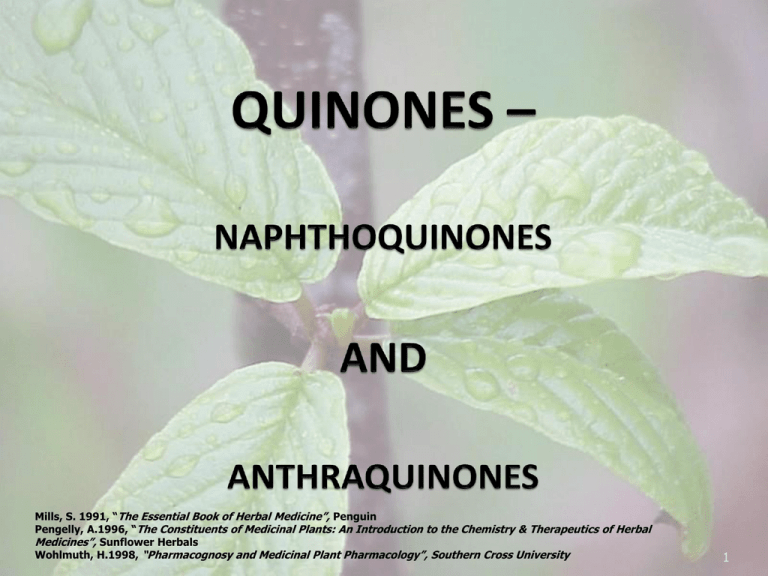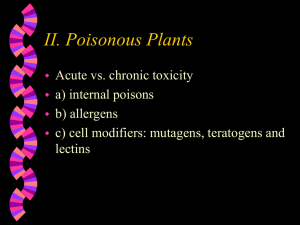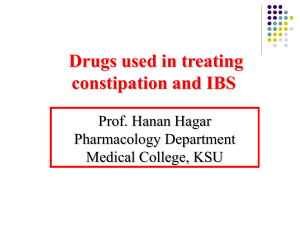
Mills, S. 1991, “The Essential Book of Herbal Medicine”, Penguin
Pengelly, A.1996, “The Constituents of Medicinal Plants: An Introduction to the Chemistry & Therapeutics of Herbal
Medicines”, Sunflower Herbals
Wohlmuth, H.1998, “Pharmacognosy and Medicinal Plant Pharmacology”, Southern Cross University
1
Derived from the oxidation of phenols,
quinones
are
closely
involved
in
photosynthesis because they have the ability
to gain and lose electrons, which enables the
conversion of light energy in a form of energy
a plant can use.
They are able to carry electrons between the
components that are involved in light
reactions.
Quinones are very lipid soluble.
2
NAPHTHOQUINONES
(Aldred 2009)
Naphthoquinones are effectively quinones
with another aromatic ring fused onto them.
They usually occur as glycosides. Refer to page
246 for the structure of the important
naphthoquinone in Tabebuia spp. – lapachol.
They have
effects.
antibacterial
and
antitumour
3
Vitamin K is an example of a naphthoquinone.
4
ANTHRAQUINONES
Yellow-brown or orangey red in colour
Can be found free or as glycosides. Most
commonly occur as O- or C- glycosides.
The basic aglycone has a central quinone with a
phenol group either side.
There are variants of anthraquinones such as
anthranals (alcohols) and anthrones (ketones)
Refer to page 95, figure 6.54 for structure
5
First isolated by French chemists in 1832.
Plants containing anthraquinone glycosides
have laxative effects. Some of these botanical
drugs have been used extensively in orthodox
medicine.
Although anthraquinone laxative have a role to
play in herbal medicine, their use is limited. This
is because a holistic approach to constipation at
least initially will focus on dietary changes,
increased fluid intake, increased exercise and
the use of bulk laxatives. Anthraquinones are
often seen as the last resort.
6
Anthraquinone laxatives should be used for short
term only, and they should be phased out of
treatment in a week to ten days. An exception to
this rule is Rumex crispus which contains
relatively small amount of anthraquinone and is
normally used more as an alterative rather than
as a laxative.
Anthraquinones should always start with a low
dose and increase until the desired effect is
achieved.
Herbs containing emodin-based glycosides
colour the urine yellowish-brown when it is acid,
reddish or violet when alkaline.
7
Prolonged use can lead to potassium depletion
(of particular concern in patients taking
cardioactive glycosides e.g. digoxin)
Prolonged use can cause pigmentation of the
intestinal mucosa, this is reversible and
believed to be harmless.
The duration of action is around 8 hours and is
usually recommended before bed.
Direct anthraquinone derivatives include the
following:
Rhein from Rheum, Rumex crispus and Cassia
spp
Emodin from Rhamnus spp.
Aloe-emodin from Rheum and Cassia spp.
Chrysophanol from Rheum and Rumex spp.
9
Anthraquinone containing medicinal plants with
medicinal use include the following:
Cassia senna fructus
Alexandrian senna fruit
(pods)
C. Angustifolia fructus
Tinnevelly senna fruit (pods)
C. senna/angustifolia folia
Senna leaf
Rhamnus purshiana cortex
Cascara bark
Rhamnus frangula cortex
Frangula bark
Rheum palmatum radix
Rhubarb root
Rheum officinale radix
Rhubarb root
Rumex crispus
Yellow dock
Aloe barbadensis
Aloes
They can also be found in:
Hypericum perforatum
Cephaelis spp.
Arctostaphylos uva-ursi
Vaccinium myrtillus
Ricinus communis (castor oil plant)
A number of fungi and lichens
11
Pharmacokinetics (Aldred 2009)
Most anthraquinones pass through the stomach
and small intestines unaltered, but in the
caecum and colon they are converted to
dianthrones (their aglycones) by microorganisms. The dianthrones, which remain
unabsorbed, are further transformed into
anthrone and anthraquinone.
The glycosides of anthraquinones and dianthrones
are polar and therefore not easily absorbed across
the phospholipid membranes of the cells of the gut
wall.
Once the bacteria have cleaved the sugar off, the
compound becomes non-polar and is absorbed
across the non-polar cell membrane of the gut wall
cells.
Excessive consumption of anthraquinones can cause
severe disruption of the colon with resultant pain
and diarrhoea. The length of the use of herbs
containing anthraquinones should therefore be
limited.
13
The action of an anthrone is excessively vigorous,
which is why certain herbs, such as Frangula,
have to be stored for around a year before use.
The storage time allows the anthrones to become
oxidised so that they form the less reactive
anthraquinone glycosides.
Instead of storage for a year, it could be ‘aged
artificially’ by heating it for several hours to 80 100° C (Heinrich et al p. 204)
14
PHARMACOLOGY
Anthraquinones act directly on the intestinal
mucosa by influencing several pharmacological
targets and, as such, act as osmotic laxatives in
the colon:
The laxative effect is due to increased
peristalsis of the colon. This results in a
reduced transit time and a consequent
inhibition of re-absorption of water from the
colon
Additionally, the stimulation of active chloride
secretions, sodium and water results in an
inversion of normal physiological conditions
and a subsequent increased excretion of water.
15
Overall, this results in an increase of the
faecal volume in the bowel causing peristalsis
which results in the bowel motion.
Therefore, anthraquinone laxatives act by
increasing peristalsis in the lower part of the
digestive tract. The previous held view that
they work through irritating the bowel, does
not apply when used in normal doses. In
summary, anthraquinone containing plants
selectively stimulate peristalsis, they do not
stimulate digestive function in general.
16
Prostaglandins also play a role in the laxative
action of anthraquinones. In vivo studies has
suggested that the decreased intestinal transit
time caused by rhein anthrone is in part due
to increased production of prostaglandins.
The sensitivity to anthraquinone laxatives
vary markedly: this is largely because of
differences in bowel flora. Human intestinal
bacteria that can hydrolyse anthraquinone
glycosides include Clostridium sphenoides, C.
butyricum,
Eubacterium
sp.
and
Bifidodacterium adolescentis.
17
Free anthraquinones (i.e. non-glycosidal) have
no laxative effect. Therefore, they cannot reach
the colon unchanged but are either chemically
altered or absorbed. It is possible that the free
anthraquinones are responsible for causing the
griping effect which is sometimes seen as an
unwanted side-effect. In order to prevent griping,
anthraquinone laxatives are always given with
carminatives and /or/ spasmolytics e.g. Zingiber
officinale or Foeniculum vulgare.
The role of the bowel flora has been firmly
implicated (e.g. it has been established that
sennosides are hydrolysed to sennidins, then
reduced to rheinanthrone, a purgative active
principle.
Once in the blood stream the aglycone is
absorbed into as yet untargeted cells and
processed there (probably emodin in all cases).
Here it affects the protein biosynthetic pathway,
probably leading to the formation of enzymes
(all this is supposition based on the 8 -14 hours it
takes for an ingested dose of anthraquinone to
be active: this is typical time frame for protein or
19
enzyme synthesis to be affected.)
The final result seems to be the release of
prostaglandins, which increase the irritability
of the smooth muscle cells of the bowel wall.
20
Classification
From the previous slides, we can see that
Anthraquinones are divided into 5 groups:
1. Anthraquinone glycosides: usually refers to any
glycoside with an aglycone from the groups
below. Most are O-glycosides, but C-glycosides
also occur e.g. aloin. Many are based on the
anthraquinone aglycone emodin.
2. Anthraquinone aglycones: no laxative effect
when taken orally but may be responsible for
the griping. Rheum spp contains mostly
glycosides with anthraquinone aglycones, e.g.
rhein and emodin (found in frangula).
21
Anthranols and anthrones: anthraquinone
derivatives, occur in free form or as glycosides.
Rhamnus purshiana contains mostly anthrone
glycosides, the cascarosides.
Oxanthrones: these are less common. Occur in
Rhamnus purshiana.
Dianthrones: derived from two anthrone
molecules.
Important
aglycones
of
the
sennosides and occur in Cassia spp and Rheum
spp.
22
Actions and indications
Although anthraquinones are best known for
their laxative properties and that is:
Constipation
Conditions in which easy defecation with soft
stools is desirable e.g. haemorrhoids or anal
fissures
23
They do have a variety of other actions:
Anti-inflammatory
Anti-psoriatic activity when applied topically
Anti-viral: anthraquinones inhibit cytomegalo-virus and
inactivates enveloped viruses including herpes simplex
virus type 1 and 2, varicella-zoster virus and influenza
virus in vitro
Aloe-emodin inhibits the growth of Helicobacter pylori in
vitro
Rhein is significantly antiseptic and toxic to Shigella
dysenteriac and Staphylocci.
24
Contraindications
Intestinal obstruction
Inflammatory bowel conditions
Appendicitis
Abdominal pain of unknown cause
Pregnancy
Lactation – no laxative effect from the milk but small
amounts of anthraquinone aglycones in milk may
present a risk for causing griping in child.
25
Anthraquinone laxatives are often used on a
daily basis as they can’t move their bowels
without them. The general rule is that the
prolonged use of this type stimulant leads to an
increasing loss of tone of the tissues stimulated,
that is, the underlying atonicity becomes worse.
The only justified use, according to Mills 1998, is
as a short term measure, to move an ongoing
congestion or as part of a broader re-education.
Mills states that an effective approach is to use
one part of an anthraquinone-containing
remedy with two parts of chamomile and four
parts of psyllium or linseed for a period of up to
six months. Even the most atonic bowel can have
its tone restored with such a mixture.
26
Hypericin, the dark red pigment from
Hypericum perforatum is a dehydrodianthrone,
structurally an anthraquinone. It is two of the
same anthrone joined together to form a
homoanthrone. Therefore, it does not break
down to anthraquinone in the bowel and is
without laxative action.










